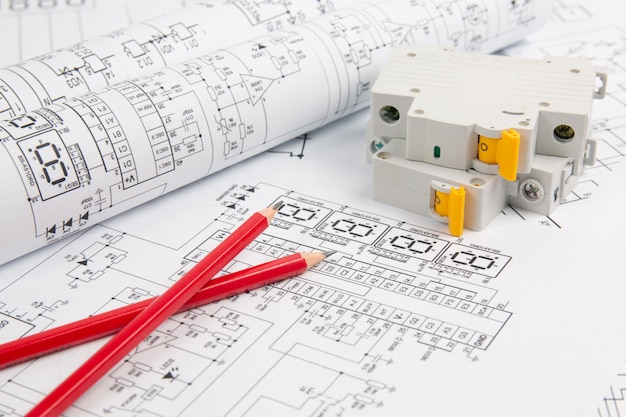As a discerning building owner in the vast and diverse state of Texas, understanding the intricacies of your property’s electrical infrastructure is paramount. One crucial aspect of this comprehension is the Electrical Riser Diagram. In this article, we’ll unravel the significance of Electrical Riser Diagrams, why they matter, and how building owners in Texas can benefit from a clear understanding of these visual representations.
Table of Contents
What are Electrical Riser Diagrams?
Electrical Riser Diagrams, often referred to as one-line diagrams, are visual representations of a building’s electrical distribution system. These diagrams provide a simplified illustration of how electrical power flows from the main service entrance to various components within the building. Think of it as a roadmap that guides you through the journey of electricity within your property.
Understanding the Components:
The first step in deciphering an Electrical Riser Diagram is understanding its key components. At the top of the diagram, you’ll typically find the main service entrance, representing the point where electrical power enters the building from the external power source. From there, lines branch out to depict the distribution of power to different sections or floors of the building.

Each line on the diagram represents an electrical conductor, whether it’s a wire, cable, or busbar, conveying power to switches, panels, and outlets throughout the building. Symbols are used to denote various components such as circuit breakers, transformers, and other key elements of the electrical system.
Why Do Electrical Riser Diagrams Matter?
Clarity in System Design:
Electrical Riser Diagrams serve as an invaluable tool for gaining clarity on the design and layout of your building’s electrical system. For building owners in Texas, where properties can range from residential homes to expansive commercial structures, having a clear understanding of how power is distributed ensures informed decision-making, especially during renovations or expansions.
Troubleshooting and Maintenance:
In the event of an electrical issue or during routine maintenance, Electrical Riser Diagrams become essential reference documents. The visual representation allows electricians and maintenance personnel to quickly locate components, identify potential points of failure, and streamline the troubleshooting process. This efficiency is particularly crucial in Texas, where electrical systems may face challenges due to varied weather conditions.
Compliance with Regulations:
Texas, like any other state, has specific electrical codes and regulations that dictate the design and installation of electrical systems. Electrical Riser Diagrams play a crucial role in demonstrating compliance with these codes. Whether it’s for obtaining permits, passing inspections, or ensuring the safety of your property, having accurate and up-to-date diagrams is a non-negotiable aspect of building ownership.
Planning for Upgrades and Expansions:
As a building owner, you might contemplate upgrades or expansions to accommodate changing needs. Whether it’s adding new office spaces, upgrading electrical panels, or incorporating energy-efficient solutions, Electrical Riser Diagrams provide a foundational understanding of your current system. This knowledge is invaluable when planning for modifications, ensuring seamless integration and adherence to safety standards.
The Role of Symbols and Abbreviations:
When reviewing Electrical Riser Diagrams, it’s essential to familiarize yourself with the symbols and abbreviations used. For instance, a simple square might represent an outlet, while a zigzag line could denote a resistor. Understanding these symbols enables you to interpret the diagram accurately and communicate effectively with electricians and other professionals involved in your property’s electrical systems.
Collaboration with Electrical Professionals:
Interpreting Electrical Riser Diagrams may seem complex, especially if you’re not well-versed in electrical engineering. This is where collaboration with licensed electrical professionals becomes crucial. These experts can guide you through the intricacies of the diagrams, ensuring that you make informed decisions about your property’s electrical infrastructure.
The Process of Reading Electrical Riser Diagrams:
Reading Electrical Riser Diagrams involves following the flow of power from the main service entrance through various components to different areas of the building. It’s like reading a map; you start at the top, follow the lines, and understand how electricity is distributed. Taking the time to familiarize yourself with the diagram pays off in improved decision-making, better troubleshooting, and enhanced overall system understanding.
Maintaining Updated Diagrams:
The dynamic nature of properties in Texas, coupled with the evolving nature of electrical systems, underscores the importance of keeping Electrical Riser Diagrams up to date. Any modifications, additions, or upgrades to the electrical system should be reflected in the diagrams promptly. This ensures that the documentation remains an accurate reflection of the current state of your property’s electrical infrastructure.
Conclusion:
In conclusion, for building owners in Texas, mastering the language of Electrical Riser Diagrams is a strategic endeavor. These diagrams offer a visual roadmap to understand, troubleshoot, and plan for the electrical systems within your property. From ensuring compliance with regulations to facilitating upgrades and collaborations with electrical professionals, the significance of Electrical Riser Diagrams cannot be overstated. Embracing these visual representations empowers building owners to navigate the complexities of their electrical infrastructure with confidence and clarity.




